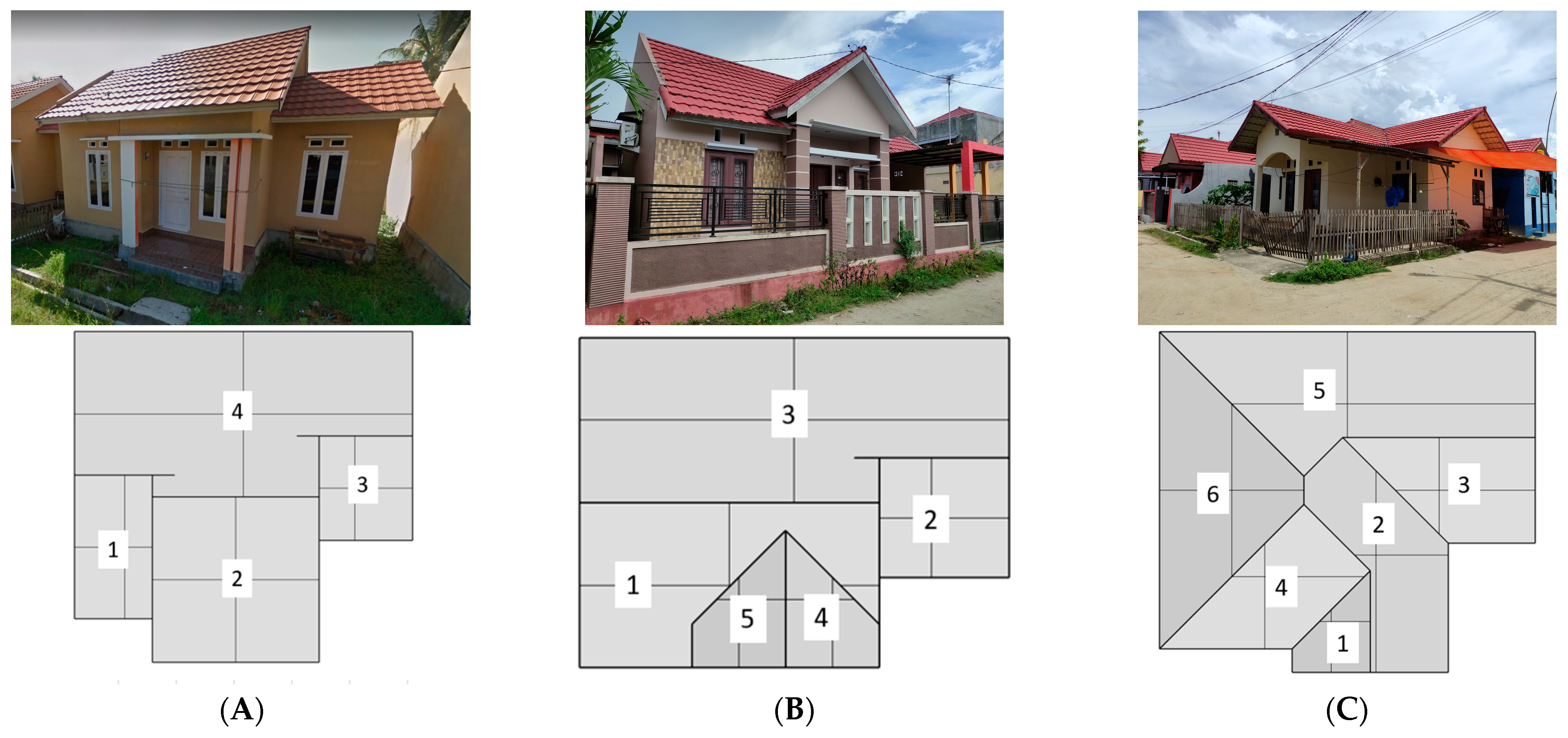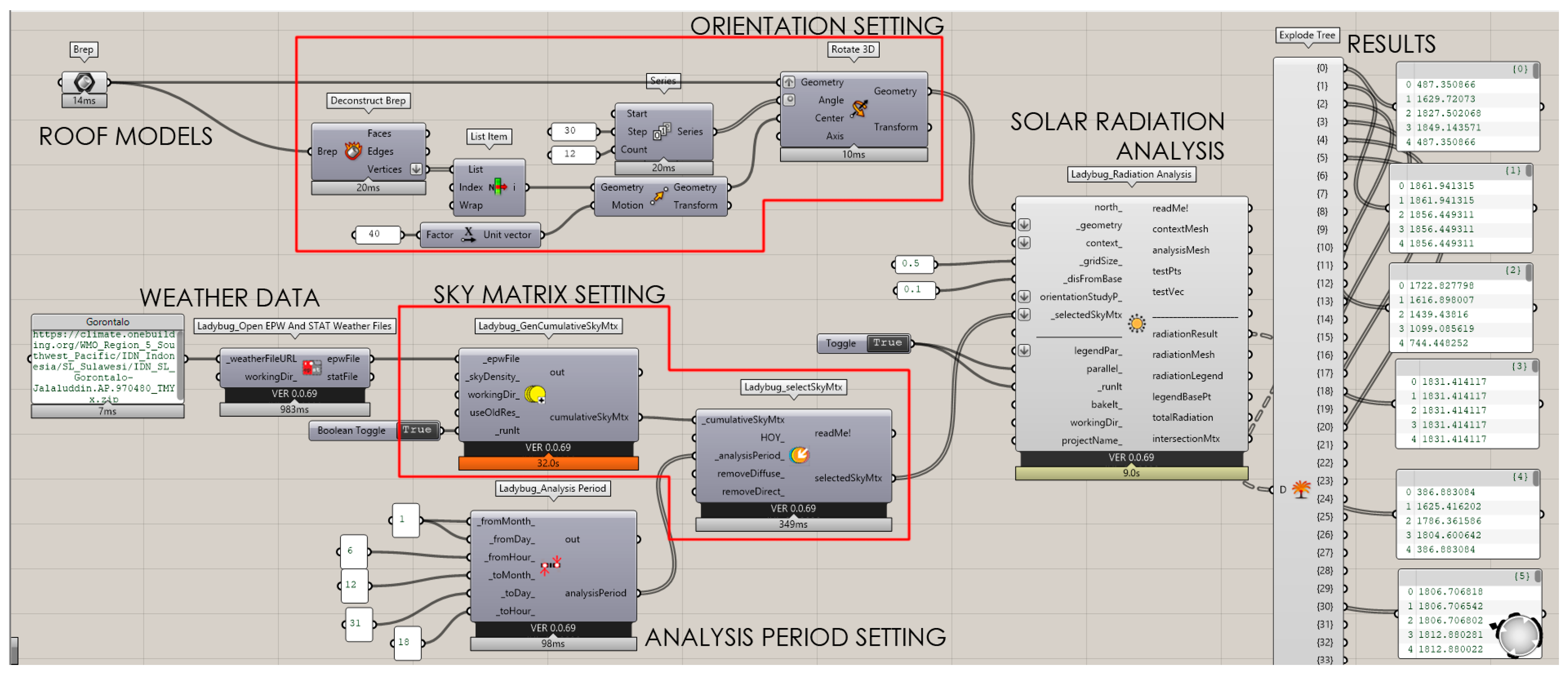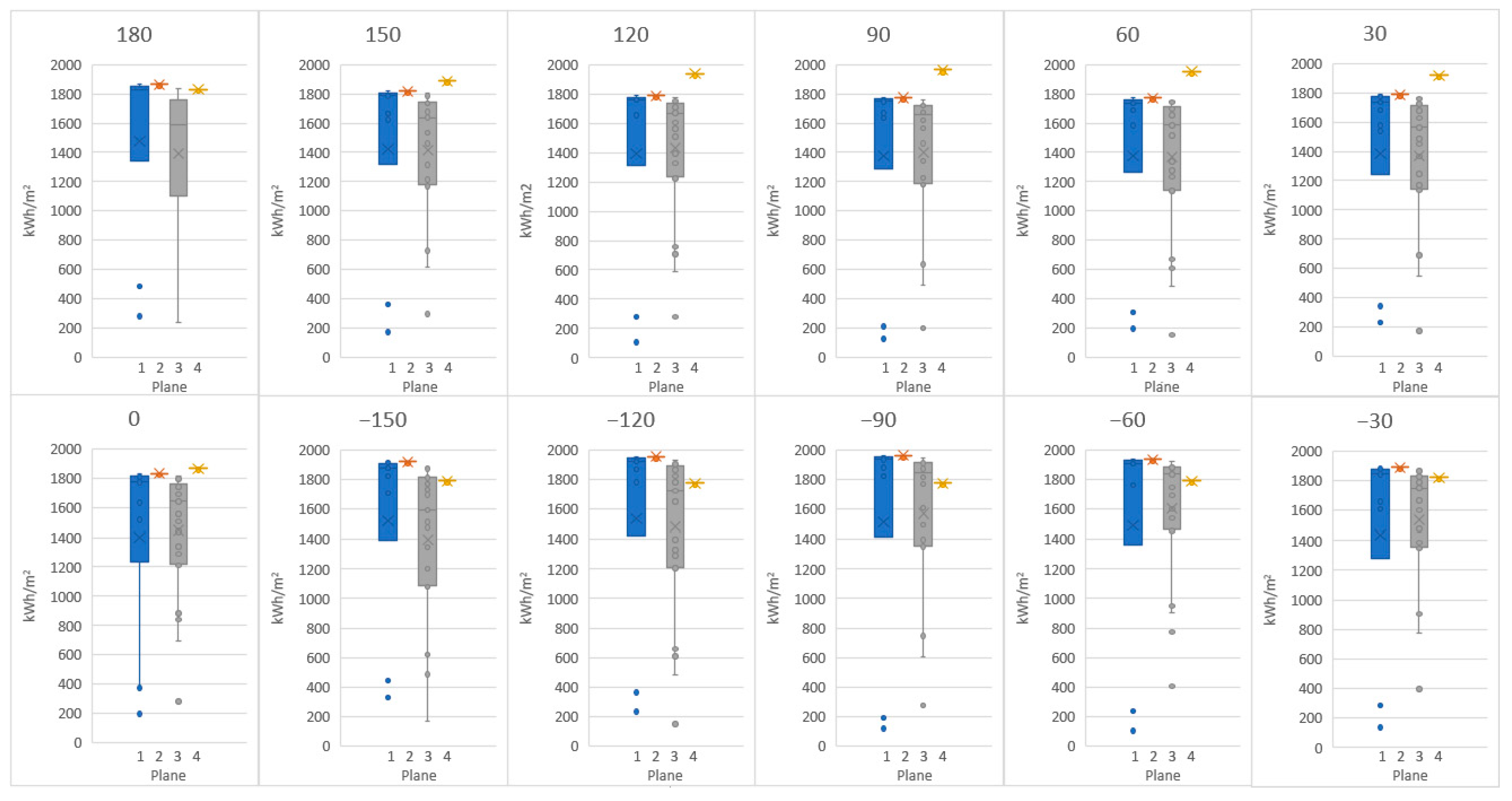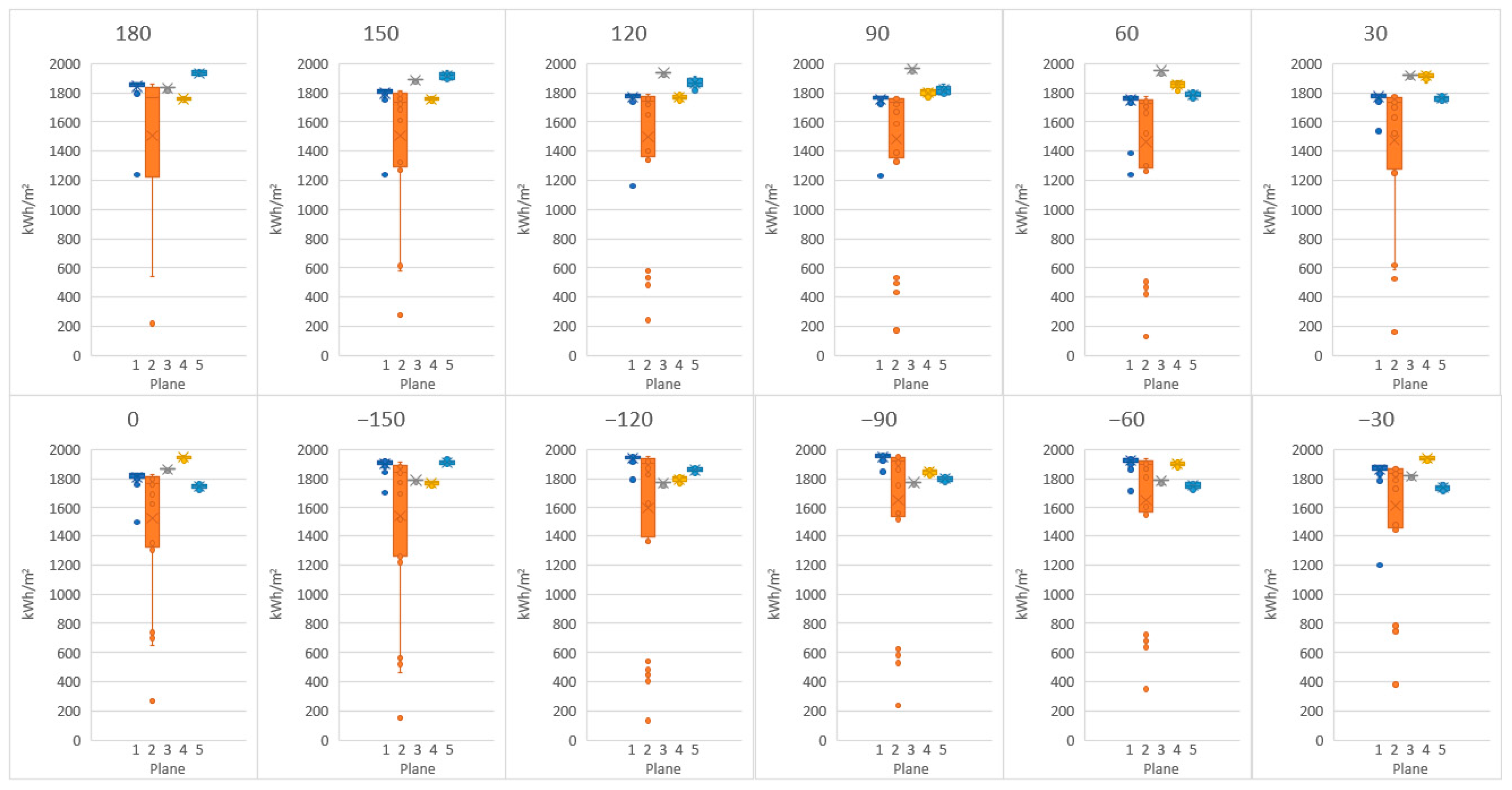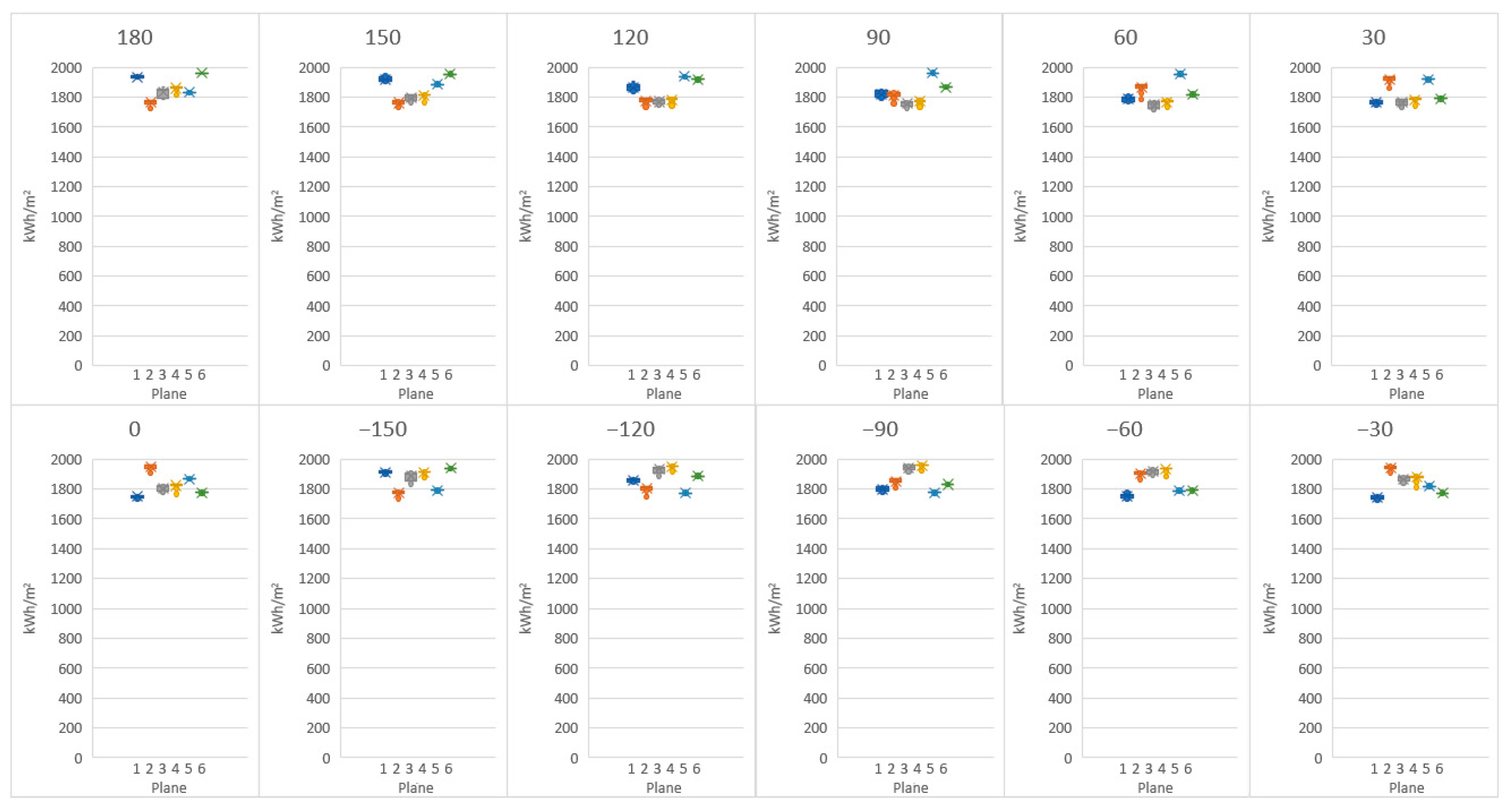1. Introduction
The Indonesian government has set a national energy plan to use a minimum of 25% of the roof area for building solar power plant roofs on residential buildings [
1]. However, the roofs of Indonesian housing are varied in design. There is no specific instruction on the obligation to install solar panels on roofs. People will be facing problems such as where they should put their renewable energy facilities in their house. Housing developers construct their housing roofs in a variety of shapes to attract buyers. Some of them are irregular roof shapes, which become a hindrance for PV in roof installation [
2].
There are many different studies on the potential of a PV roof to generate energy, with emphasis on roof shapes. Barbón et al. found a general algorithm to optimize the deployment of photovoltaic panels installed on irregular flat roof shapes. The algorithm takes into account the irregular rooftop shape, the self-shading of the photovoltaic panels, and some essential variables [
3]. Bayón et al. provided the optimal distribution of PV panels on rectangular rooftop shapes. [
4]. Moreover, Ioannou et al. presented the optimal configuration of the PV panel rows installed on a square-shaped rooftop [
5]. In addition, Barbón et al. [
6] determined the optimal distribution of PV panels on the simple shapes of rooftops. Unfortunately, the studies on the topic of PV on a roof mentioned above only consider a flat rooftop as the place to set up PV.
In terms of PV on housing, Esfahani et al. found that shed roofs gain the maximum solar energy in Perth, Australia [
7]. However, a shed roof is a simple one-plane roof and can hardly be found in Indonesia’s housing. Hachem et al. conducted a study on the effect of the housing geometric form on façade BIPV solar potential [
8]. The research did not consider PV on the housing roof. Palmer et al. identified the most suitable buildings based on roof shading but did not take into account the roof shape [
9].
The previous articles dealt with the optimalization of PV panels on regular rooftop shapes and regular pitch roof shapes. There is a need to study PV installation in the irregular-pitch roof shape. This paper discusses the PV potential for the complex shapes of housing roof found in Indonesia. The aim is to evaluate the suitable roofs for PV installation on the common housing roof style found in Gorontalo, Indonesia, with the addition of the influence of the Sun’s annual movement around the equator.
2. Materials and Methods
Three complex designs of housing roofs are selected to assess the suitability of PV panel installation, as can be seen in
Figure 1. They are stacked gable roofs (A), complex gable roofs (B), and complex hip roofs (C). Stacked gable roofs are the most common roof types found in housing in Gorontalo city [
10]. Roof A consists of 3 rectangular planes and an irregular plane. Roof B has a rectangular plane, 2 trapezoid planes, and 2 irregular planes. Roof C has 4 trapezoid planes and 2 irregular planes. Roofs A and B have a higher roof part and provide shade for the lower roof part. Planes on roof A only face 2 directions, while B and C face 4 directions. Each roof shape has advantages and disadvantages for PV installation. Rectangular planes provide a fitting shape for the common rectangular PV panel, while PV panels are more difficult to fit in trapezoid and irregular planes.
Prior to this study, an investigation on the best roof orientation in Gorontalo showed that west-facing surfaces obtain the most solar radiation compared to other orientations [
11]. Housing roofs could be facing any direction, but among the 3 roofs, roofs B and C have one of their planes facing west. However, even though the planes are facing west, the existence of self-shading on roofs A and B could reduce the annual solar radiation gains. Therefore, a study on solar radiation gains in several directions of the selected housing is necessary to find out which roof shape provides the most suitable space for PV installation on roofs.
The study in this article deals with radiation gain on pitch roofs under the following conditions: (i) irregular roof shapes; (ii) self-shading of the roof; (iii) roof orientations. The roofs’ performance will be simulated using Ladybug’s components in Rhinoceros 3D. Simulation flow can be seen in
Figure 2. Roof models are set to face 12 directions from 0° to 330°. In this paper, the directions will be expressed in azimuth (0°, 30°, 60°, 90°, 120°, 150°, −30°, −60°, −90°, −120°, −150°, and 180°)
. Simulation is performed for a year-round analysis, from 6 to 18. The performance indicator is annual solar radiation (kWh/m
2) falling on grid points of roof planes. The grid size is 0.5 m, and the visualization of the grid size on the roof plane is given in
Figure 3. Each plane of a roof is numbered; thus, the performance of each plane is comparable. The simulation results of each roof type and orientation are plotted into box and whisker charts and then compared. To analyze the plane for mounting capacity, a packing method is employed to determine how much PV can fit in a roof plane. A 550 Wp panel (size of 2279 mm × 1135 mm) is selected as the size to fit in the plane area. The above analysis objective is to find which housing roof shape provides more consistent solar gain and which roof shape provides more space for PV panels.
3. Results and Discussion
An analysis of the suitable roof design for PV installation is discussed in two subsections. The first part reviews solar radiation gain on the planes of the three housing roof designs. The second part examines the mounting capacity of the roof planes.
3.1. Analysis of Solar Radiation Gain
The comparison of simulation results in 12 directions can be seen in
Figure 4,
Figure 5 and
Figure 6. From the charts below, it can be noticed that the annual solar radiation gain on plane 1 in roof A has a wide span of values ranging from 106 to 1961 kWh/m
2. Plane 3 in roof A also delivers similar results, from 150 to 1946 kWh/m
2. Likewise, plane 1 in roof B has varying values from 106 to 1961 kWh/m
2, while plane 2 in roof B ranges from 152 to 1955 kWh/m
2. On the other hand, there is no specific plane in roof C that has such a large interval of values. Even though on different directions, the solar radiation gain on the planes of roof C shows different result, the values generally range from 1715 to 1963 kWh/m
2.
The enormous deviation of solar radiation gain in roofs A and B is provided by the effect of self-shading. The inconsistency of the solar radiation gain on a plane renders the roof’s solar performance low. It is preferable to install a PV panel on a roof with a lower deviation to maximize energy production. Consequently, planes 2 and 4 are recommended as PV installation planes for roof A. Planes 2, 3, and 4 are recommended for roof B. As for roof C, there is no self-shading effect found on the roof, and so all of the planes are acceptable for PV installation.
3.2. Analysis of PV Mounting Capacity
There is only a slight difference in the solar radiation gain in different orientations of roof C, which promotes it as a high-performance roof compared to the other roof design. However, when it comes to PV mounting, there are unmountable planes due to the trapezoidal and irregular plane shape of roof C. Roof planes for PV mounting are selected based on the area with no self-shading. As can be seen in
Figure 7, there is more space to mount PV panels on roof A compared to roofs B and C. The utilized method of PV packing on the roof, as demonstrated below is still lacking, as some occupiable space is not filled with PV panels. Still, the results favor roof A.
4. Conclusions
A stacked gable roof is the most common roof shape found in the design of detached housing in Gorontalo. Some roof shapes, such as complex gable and complex hip roofs, were also observed in the city. They can be differentiated by the plane shape, directions, and the existence of self-shading. Research on the potential of PV installation on the three roofs results in a stacked gable roof as the best roof shape to provide renewable energy to the housing with the condition that PV panels should not be mounted on the planes that are shaded by the other roof parts.
Complex hip roofs have planes facing four directions. There is no self-shading effect on the roof, and all of the planes are suitable for PV installation. Nevertheless, the presence of trapezoid and irregular planes poses a hindrance for the installation of larger PV panel sizes and limits increased energy production.
Author Contributions
Conceptualization, Methodology A.G.D.; Formal Analysis A.G.D. and N.P.; Writing—original draft, A.G.D. and R.; Visualization, Writing—review and editing, N.M. All authors have read and agreed to the published version of the manuscript.
Funding
This research received no external funding.
Institutional Review Board Statement
Not applicable.
Informed Consent Statement
Not applicable.
Data Availability Statement
The data presented in this study are available on request from the corresponding author.
Conflicts of Interest
The authors declare no conflict of interest.
References
- Peraturan Presiden Republik Indonesia. Rencana Umum Energi Nasional. 2017. Available online: https://www.esdm.go.id/assets/media/content/content-rencana-umum-energi-nasional-ruen.pdf (accessed on 7 November 2023).
- León, E.Z.; Alvarado, R.G.; Arriagada, R.S.; Baeriswy, S. Assessment of integrated performance and roof geometry for solar energy. Open House Int. 2016, 41, 73–81. [Google Scholar] [CrossRef]
- Barbón, A.; Ghodbane, M.; Bayón, L.; Said, Z. A general algorithm for the optimization of photovoltaic modules layout on irregular rooftop shapes. J. Clean. Prod. 2022, 365, 132774. [Google Scholar] [CrossRef]
- Bayón-Cueli, C.; Barbón, A.; Fernández-Conde, A.; Bayón, L. Optimal distribution of PV modules on roofs with limited space. In Proceedings of the 2021 IEEE International Conference on Environment and Electrical Engineering and 2021 IEEE Industrial and Commercial Power Systems Europe (EEEIC/I&CPS Europe), Bari, Italy, 7–10 September 2021. [Google Scholar] [CrossRef]
- Ioannou, A.K.; Stefanakis, N.E.; Boudouvis, A.G. Design optimization of residential grid-connected photovoltaics on rooftops. Energy Build. 2014, 76, 588–596. [Google Scholar] [CrossRef]
- Barbón, A.; Bayón-Cueli, C.; Bayón, L.; Rodríguez-Suanzes, C. Analysis of the tilt and azimuth angles of photovoltaic systems in non-ideal positions for urban applications. Appl. Energy 2022, 305, 117802. [Google Scholar] [CrossRef]
- Esfahani, S.K.; Karrech, A.; Cameron, R.; Elchalakani, M.; Tenorio, R.; Jerez, F. Optimizing the solar energy capture of residential roof design in the southern hemisphere through Evolutionary Algorithm. Energy Built Environ. 2021, 2, 406–424. [Google Scholar] [CrossRef]
- Hachem, C.; Athienitis, A.; Fazio, P. Parametric investigation of geometric form effects on solar potential of housing units. Sol. Energy 2011, 85, 1864–1877. [Google Scholar] [CrossRef]
- Palmer, D.; Cole, I.; Goss, B.; Betts, T.; Gottschalg, R. Detection of Roof Shading for PV Based on Lidar Data Using a Multi-Modal Approach. In Proceedings of the 31st European Photovoltaic Solar Energy Conference and Exhibition, Hamburg, Germany, 14–18 September 2015. [Google Scholar]
- Djafar, A.G.; Rahmayanti; Saputra, W.; Kaharu, A. Construction Analysis of Housing’s Roof in Gorontalocity. J. Build. Archit. 2023, 1, 10–15. [Google Scholar] [CrossRef]
- Djafar, A.G.; Mohamad, Y. Method to assess the potential of photovoltaic panel based on roof design. Int. J. Appl. Power Eng. 2022, 11, 186. [Google Scholar] [CrossRef]
| Disclaimer/Publisher’s Note: The statements, opinions and data contained in all publications are solely those of the individual author(s) and contributor(s) and not of MDPI and/or the editor(s). MDPI and/or the editor(s) disclaim responsibility for any injury to people or property resulting from any ideas, methods, instructions or products referred to in the content. |
© 2023 by the authors. Licensee MDPI, Basel, Switzerland. This article is an open access article distributed under the terms and conditions of the Creative Commons Attribution (CC BY) license (https://creativecommons.org/licenses/by/4.0/).
